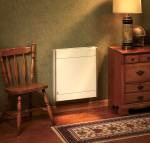Search engine visitors - click here to access entire "$ensible Home" web site
Click here to see a descriptive illustration of several designs of gas, propane, kerosene direct-vent space heaters
Dear Jim: I need a gas space heater to take the chill off a large family room. I want one which continues to heat during emergency power outages. What options do I have and which are most efficient and safe? - Kim R.

A: You have many options from which to select depending on your budget and the features you desire. The most efficient and safe models are direct vent designs which are mounted against an outside wall in any room. Many operate more efficiently than your central gas furnace. Models with millivolt controls will continue to run during electric power outages.
You mentioned a gas space heater, but there are also efficient direct-vent kerosene models which are very safe to use. These may be more convenient to install because you do not have to run a gas or propane line to the heater. Also, they operate at slightly higher efficiencies than gas models.
Using a gas, propane or kerosene space heater can reduce your utility bills and improve your family's comfort by allowing you to zone heat your home. The space heater will keep your family toasty warm while they relax by the television without requiring you to overheat the entire rest of the house.
Direct-vent space heaters use sealed combustion so the combustion process is totally separate from the room air. Combustion air is drawn in from outdoors. It mixes with the gas, propane or kerosene in the burner and the flue gases exhaust back outdoors. This is safe, efficient and eliminates drafts.
To install a direct-vent space heater, a 3-1/2-inch hole needs to be cut into the outside wall. A double-wall concentric pipe runs from the back of the heater through the hole. The hot flue gases flow out the center pipe which preheats the combustion air coming in the outer pipe.
Millivolt controls use very little electricity and will continue to operate when the electricity goes off. If your space heater has an electric blower, the blower will stop when the electricity goes off, but the burner will keep going. Room air will continue to naturally flow up through the unit and keep the room warm.
Thermostatic-control is a good comfort and efficiency feature. Some have built-in thermostats or optional wall thermostats. An efficient automatic setback feature lowers the temperature two degrees at 30 and 60 minutes of operation. For continuous heating, a programmable thermostat is best. If you are a couch potato, select one with a hand-held remote control for the heat.
An optional built-in humidifier can eliminate overdrying of the room air. An efficient built-in air filter works well on models with electric blowers. If you do not have a fireplace in the room, select a space heater with a ceramic log set and a large glass door to view the flames.
Instant Download Update Bulletin No. 699 - buyer's guide of the most efficient direct-vent gas, propane, kerosene heater manufacturers (55 models) listing types of heater with illustrations (wall/floor mount, counterflow wall furnace, in-floor furnace, radiant console, through the window, dual side) efficiencies, heating capacity, sizes, comfort features and cost-to-use chart, chart on selecting the correct size heater, illustrations of selected models.
Dear Jim: We have a pretty large whirlpool bathtub that we use only occasionally. It seems like it uses all the hot water from the tank to fill it. What is the best way to heat the water for the whirlpool? - Sandi R.
A: It can get expensive to heat the water to fill a large tub which you use for only a relatively short period of time. Install a small instantaneous water heater at the whirlpool to heat its water.
When you are done using the whirlpool each time during the winter, don't drain the water until it has cooled down. There is a lot of heat energy stored in the warm water which will transfer to the room air.